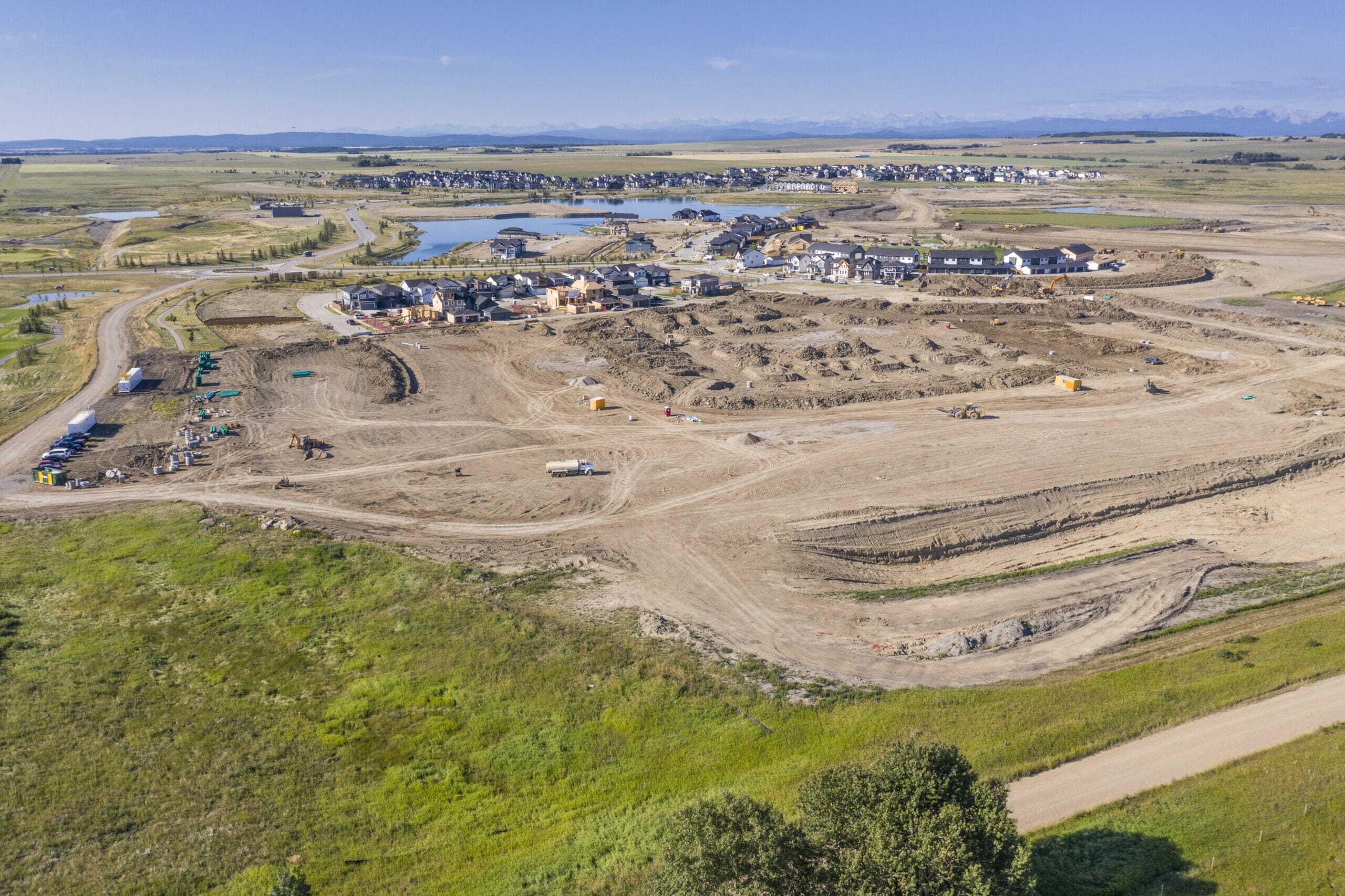Common New Community Terms – Defined
Buying a new home in a new community can be a daunting experience. There are many phrases community developers and homebuilders use that may not be familiar. Check out our cheat sheet below to get definitions of common terms used.
Development Terms
Grading: Grading is the process of raising or lowering the elevation of land to allow for servicing and home construction.
Stripping and Grading: Stripping is the removal of all organic material (grass, loam, plants) from the ground so that the site is left with silt, sand, and clay materials which are suitable for home and road construction. Grading is the relocation of soils from one area to another to bring the ground elevation close to what is needed for the construction of the community. Organic material removed from the ground during the stripping process will be reused in parks, boulevards, medians, and on finished lots as the development in the community is completed.
Shallow utilities: Shallow utilities is the term for the underground electrical, natural gas and telecommunication network that provides service for a community. They are named as such since they are shallower than the deep utilities.
(Utility) Right of Way (ROW/URW): A section of land which is set aside on lots for utility installation. Utilities which get installed in the ROW are power, gas, and telecommunications.
Deep Utilities: Deep utilities is the term for the underground storm sewer, sanitary sewer and water main network that provides service for a community. They are named as such since they are located deeper than shallow utilities.
Area Structure Plan (ASP): An area structure plan (ASP) is a long-range planning document and is the first step in obtaining planning approval for a new community. It provides a high-level information on servicing, transportation, recreation, schools, etc. for a region designated for future development.
Outline Plan: A high level plan showing block patterns, hierarchy of roadways, and distribution of open space in a new community. The outline plan is a guide for developers, which includes zoning, planned school sites, residential density (single family or multi-family sites), commercial sites, and street types.
Plot Plan: A plot plan is the blueprint for where a house/building will be on any given lot. It will provide grades, lot coverage, setbacks, drainage, foundation dimensions, and property lines.
Environmental Reserve (ER): ERs are sections of land which will not be developed due to the presence of a swamp, gully, ravine, coulee, natural drainage course, flood prone area, or proximity to a water body. They typically allow public access in the form of a park and preserve the natural features of the land.
Municipal Reserve (MR): MRs are parks built by developers that may include public trails, playgrounds, green spaces, recreational areas, sports fields, etc. A minimum of 10% of any development must be set aside for this purpose.
Municipal School Reserve/School Site: A parcel of land set aside for future school development by the designated school board.
Transit Oriented Development: Land designated for future municipal transit development. For example, a future bus route or LRT line.
Building Envelope (AC): A building envelope relates to a Plot Plan. It determines the buildable area on a lot. Bylaws play a large role in determining the building envelope on a lot.
Phase: A section of a community that is planned, designed, constructed, and released for home construction.
Commercial Area: A portion of land within a development which is set aside for commercial/retail amenities such as: grocery stores, gas stations, daycares, local businesses, etc.
Amenity: An amenity is an area designated within a community that is considered a benefit to residents. Amenities can include: parks, pathways, lakes, school sites, commercial space, etc.
Wetland: A wetland is land which has its own distinct ecosystem which is flooded or covered by water. Examples of wetlands would be marshes, swamps, or bogs. Wetlands are typically protected as they play important roles in protecting water quality and as a form of flood protection.
Storm Pond: Collect and retain precipitation before it reaches the municipal storm system. Not only can storm ponds act as beautiful spaces within the community, but they also serve to protect homes and businesses from possible flooding after a storm, reduce erosion risks, and reduce the number of sediments and pollutants entering waterways. There are several different kinds of storm ponds. Dry storm ponds remain dry and do not contain water most of the time. These “ponds” only fill with water during heavy rain, functioning in a similar way to wet storm ponds, filling with water very quickly, to prevent the stormwater system from becoming overwhelmed and causing flooding. Wet ponds hold water all year round, and water levels may rise significantly during a storm event. It is dangerous to swim in or ice skate on storm ponds as they are not designed for recreation purposes.
Storm Water KidneyTM: A storm water kidneyTM is a system that cleans stormwater by circulating the water through spaces with a diverse ecosystem of plants and aquatic creatures so that nutrients contained in the stormwater nourish the living organisms. The Stormwater Kidney® system is resilient to both droughts and floods while creating much needed biodiversity and bird habitat within urban settings.
Development Permit: This permit is granted by the Municipality to the developer to proceed with construction of their proposed development. Receiving the permit confirms that all the required parameters have been met.
Greenfield Land: Land that has never been developed.
Home Building Terms
Building Permit: It is a permit released by the Municipality granted to a builder to begin construction on a home.
Setbacks: A setback is the area from the property line to the edge of the buildable space of the lot. It is determined by the Municipality in which the development lies. The Municipality will determine what setbacks should be based on bylaws and regulations.
Lots: Are pieces of land ready for builders to purchase and sell to a buyer to build their home on.
Grade: How steep a slope is.
Building Envelope (Home): The components that separate the conditioned space from unconditioned space (roof, exterior walls) of a home. https://anhwp.com/homeowners/owning-your-new-home/new-home-warranty/
Cantilever: Is a small portion of the house which juts out on the side.
Eaves: The portion of a roof which overhangs the home. An eave is where you would install an eavestrough.
Side yards: The yard on the side of the home.
Swales: Swales are drainage channels designed to direct water overflow to a drainage basin or storm water system. Swales are long channeled depressions (bioswale), or trenched (concrete), that receive, collect and convey storm water runoff.
Home Elevation: Refers to what the home will look like at the front, the side, and the back. Often in 3D rendered or blueprint format.
Property Elevation: Property elevation refers to the grades of the plot.


